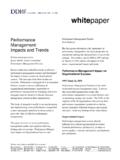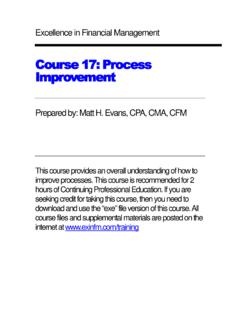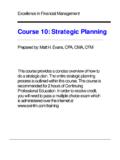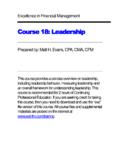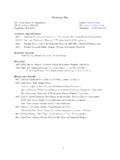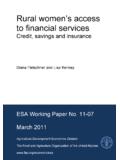Transcription of Balanced Scorecard 101 - Excellence in Financial Management
1 Balanced Scorecard 101 1 Balanced Scorecard 101 What is a Balanced Scorecard ? The Balanced Scorecard (BSC) is a performance measurement tool that originated in the business world. Performance measurement is a way to track performance over time to assess if goals are being met. The BSC was introduced by Robert Kaplan, a Harvard Business School professor, and David Norton, the founder and president of Balanced Scorecard Collaborative, Inc., in the early 1990s as a new way to measure business performance. Organizations measure their performance to monitor how they re doing in achieving their overall mission and goals. Traditionally, companies measured their performance by looking only at how they were doing financially, for example measuring only profit increases or cost efficiencies.
2 Kaplan and Norton s BSC concept challenged this traditional, single-focused approach to performance measurement. They noted that examining only Financial outcomes did not provide a company the full picture of its overall performance that it in fact ignored the other factors at play in a company s performance. Kaplan and Norton proposed that organizations consider all the factors that influence overall performance in order to get a Balanced view. They urged companies to ask and to measure, If we re going to succeed financially (the overall mission for businesses), what is it that we re doing well from our customer s perspective? and If we are to meet these customer needs, what is it that we must do well internally? By answering such questions, organizations would be considering their performance from all perspectives Financial , customer, and internal.
3 The answers to the questions would define for a company what is most important to be done in achieving the overall goal of Financial success. Once an organization identified what was most important to do, it could then develop measures to keep track of how the company was doing at those things. This collection of measures from all perspectives became what is known as the Balanced Scorecard . Today over half of Fortune 1,000 companies in North America are using the Balanced Scorecard , which has become the hallmark of a well-run organization. Many organizations say the Scorecard is the foundation of their measurement and Management systems. From the Business World to Texas Special Although the Balanced Scorecard has its roots in the business world, many public sector organizations, including the US Army, the Australia Department of Defense, and many others such as the Texas Education Agency, have recognized its value and are using the Scorecard .
4 How can a tool from the business world be of value to government agencies like the Texas Education Agency (TEA) that exist not to make a profit but to accomplish a mission by serving citizenry? It is this very nature of government organizations that makes the BSC uniquely suited for performance measurement within public agencies. While Financial performance is indeed important to agencies in terms of efficient use of taxpayer funds, performance as it relates to the customers an agency serves and the performance and effectiveness of its own internal operations is as of critical importance. As described above, the BSC is a performance measurement tool that accommodates these other very important perspectives. The National Partnership for Reinventing Government endorsed the Balanced Scorecard , saying: Why should a government [agency] try to achieve a Balanced set of performance measures?
5 Because you need to know what your customer s expectations are, and what your employees need to meet those expectations. You cannot achieve your stated objectives without taking those expectations and needs into account. Balanced Scorecard 101 2 The TEA is currently using a Balanced Scorecard at the agency level, and many of its departments and divisions are developing BSCs that measure department- or division-level performance. Those involved with Special Education at the TEA have developed a state-level Scorecard for Texas Special Education overall. This Scorecard is the one to which you will be providing input on Monday. What does a Balanced Scorecard contain? A Balanced Scorecard is made up of four components: mission, perspectives, objectives, and measures. Each of these components and how they build on each other is described below.
6 To accompany these descriptions, there is a simplistic, business-world example of a BSC on pages 3-4 that demonstrates how the various components of the BSC work together to provide Balanced performance measurement. On Monday, you will review examples specific to special education. Mission The mission is the highest, guiding level of the Scorecard . It answers the questions: What is our overall reason for being? What is our mission? Why do we exist as an organization? Perspectives Perspectives represent the various areas that influence performance and overall achievement of the mission. There are typically four to five perspectives within a Scorecard , however there can be more based on the needs of the organization. Perspectives answer the question: What are our key areas of focus in trying to achieve our mission?
7 The basic perspectives of a BSC are: Mission-level Perspective the top perspective that focuses on measuring whether an organization is achieving its overall mission. Customer Perspective focuses on what must be done, what s most important, from the customer s perspective to achieve the mission. Internal Process Perspective focuses on what an organization must be doing well to meet the customer needs defined in the Customer Perspective. Learning & Growth Perspective focuses on how an organization is improving its ability to innovate, improve, and learn in order to support success with the critical operations and processes defined in the Internal Process Perspective. The descriptions above and Example show how perspectives build on each other to support the achievement of the overall mission for an organization.
8 Objectives Within each perspective, objectives identify what needs to be done in order to achieve the overall mission. They answer the questions: What must we do (from each perspective) to achieve the overall mission? What is most important (from each perspective) to achieving the overall mission? Balanced Scorecard 101 3 There are multiple objectives for each perspective. Example provides an example of an objective within each perspective and demonstrates how the objectives and perspectives build toward the achievement of the overall mission. Measures Measures provide a way to determine how an organization is doing in achieving the objectives within the perspectives, and in turn the overall mission. They are the most actionable component in the Scorecard . For each measure, a target is set so that progress toward the objective can be evaluated.
9 Measures answer the question: How do we know how well we re doing in achieving our objectives, and in turn our overall mission? Example provides examples of measures. Example : Burgers-R-Us Balanced Scorecard The following scenario is based on a fictitious company, Burgers-R-Us, a fast food restaurant. The example Balanced Scorecard for Burgers-R-Us is on the following page. Burgers-R-Us overall goal - its mission - is to sell the most burgers. Traditionally, to see if they were meeting that goal, the president of Burgers-R-Us, Mr. H. M. Burger, would track and monitor how many burgers they sold. This traditional way of measuring performance is a one-dimensional approach, examining only the ultimate results of the Burgers-R-Us business. This approach does not give insight into the factors that influence or affect those results.
10 How does the president of Burgers-R-Us know what his organization must do to sell more burgers? If he falls short of his goal, how does he diagnose where the problem is? By measuring Burgers-R-Us in the traditional way, President Burger could only assess his business from one perspective. (the Mission-Level Perspective) So President H. M. Burger asks himself, What is it that sells more burgers? He answers, Great service. It s what the customer demands! (Customer Perspective/Objective) But how does Burgers-R-Us deliver great service? Servers must deliver food efficiently and with a smile. (Internal Process Perspective/Objective) So how do servers learn the process for quickly shuttling burgers to trays and for interacting with customers? They re trained in the latest techniques.




